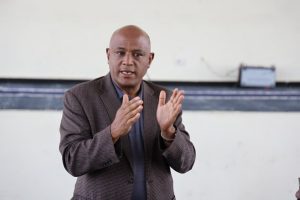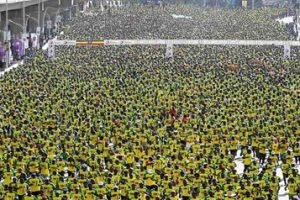(Part I)

T se Tse fly or scientifically known as Glossina species and Gendi in Amharic had been a major issue of concern in Ethiopia with its overwhelming prevalence in the nineteen sixties. The farmers who had inhabited the affected areas were in desperate need of help for the situation proved disastrous to their livestock. That was when a young Ethiopian researcher consecrated his time and energy to troubleshoot the challenge. He threw his full weight behind finding remedies such as bringing into life a technology that militates against or eradicates Tse Tse fly. He has managed to register groundbreaking achievements. His name is Dr. Getachew Ticoobet and he is today’s guest on The Ethiopian Herald.
The Ethiopian Herald: Could you brief us about yourself?
Dr. Getachew Ticoobet: I was born here in Addis and went to Qusqwam Elementary School for my primary education. I spent some time there and moved to Mekele (of Tigray State). I continued my education in Meserete Temhirt Bet and Emperor Yohanes Schools until grade eleven. Then I joined Beide Mariam Laboratory (Demonstration) School, which enrolled outshining students drawn from different provinces after competitions. After taking a one year course, I completed high school and came back to Addis for college studies in 1963. I joined the Science Faculty of Addis Ababa University (AAU) to study Biology as my major and chemistry as a minor field.
Herald: what did it feel like spending a childhood life both in Addis and Mekele then coming back to the capital city? What was the difference in terms of academic and other life experiences?
Getachew: Well the teaching methodologies and materials even the books in Addis were different from the ones in Mekele. Therefore, I experienced a little bit of confusion being a new comer in Mekele. The culture and languages were also different. As such, I needed some time to adapt myself to the new situation. The people and my teachers were very much helpful.So I managed to cope up with everything and move on. When I returned to Addis I found many things were changed. Meanwhile, I realized going through such experiences could shape one’s personality for good.
So, I joined college. But during that time students that came from Beide Mariam, like me, were needed to join the science faculty. My interest was to study medicine. But the Science Faculty dean informed me the university was badly in need of brilliant teachers. He convinced me that there is nothing I could lose if I join the faculty. He convinced me that I could rather stand a chance to be a lecturer at the University.
Just as he told me, I became a lecturer for I was one of the outstanding graduates. Thus, I joined the entomology department and became a lecturer for a year. Then the University gave me the chance to pursue my MSC. Thus I conducted my research on Tse Tse fly, which proved a turning point in my professional life.
Herald: Could you explain why or how?
Getachew: During that time, the issue of Tse Tse fly was an argumentative case between scholars splat into two to decide whether it is a serious problem or not. But I had been crisscrossing different lowland areas like Gibe valley, Gojeb and Fincha for field tasks. When I observed the situation, I understood that the challenge was very critical. I realized that it would cause a lot of damage. In the Gibe valley Elephant Grass was thriving, which was scientifically known as Hyperemia Species.
Often it was three meters tall. In the presence of this grass Tse Tse fly proves ubiquitous. So, how come this situation could be considered as less problematic? Who would do such inconsiderate assessment? I used to ask myself these questions and went back to Addis. My immediate action was making a deep assessment of a research made by a British scholar.
According to his finding, about 84,000 square kilo meter fertile land was invaded or occupied by Gendi. But my assumption was it could be more than that even though it had to be verified. Therefore, I took the issue to discuss it with different scholars. It was noted as a fact that the case was not only Ethiopia’s but also Africa’s agenda. It was a problem that affected most of the tropical African countries, which is the green area of the continent.
Taking into account that it was a Pan African issue of concern, I gave it a special attention and started working hard on it.
I conducted my MSC research in AAU collaborating with the London school of Hygiene and Tropical Medicine and Oxford universities. That was how I made my MSC degree.
Herald: So, what was the outcome of your research?
Getachew: In my result I proved that when it comes to prevalence of Tse Tse fly Ethiopia has the highest record. Meanwhile, the issue was discussed in different scientific forums and some of them doubted my finding because until I reported the result the distribution of the fly was known to confine to an altitude of 18,800 meters.
When I was conducting my research, it had already increased by 200 meters. As a result, the prevalence of Tse Tse fly was evident on 200, 000 square kilo meter of land. That was not good news! Had there been a controlling mechanism and enough effort, the prevalence rate would have ramped down to the extent of elimination.
That did not happen because measurements or actions used to be taken based on wrong information and data.
After all the discussions and doubts voiced, the fact was proven. The then International Livestock Center for Africa (ILCA) now International Livestock Research Institute (ILRI) published it on the New Scientist Journal. Then after, many began inviting me to present the case on internationalseminars. Pledges to support my research program started welling up.
Therefore, a Tse Tse fly research center was established. While I was working in the research center, I was offered several scholarships for my PhD from different international institutions but the then Director General of ILCA insisted that I should stay at the center.
He convinced me to continue on my research in Ethiopia and told me that ILCA would provide all the supports to take the necessary courses. It was an acclaimed institution. The chance I was offered to continue doing the thing that I have been deeply connected with and in my own country was a big opportunity seen in light of the other scholarships I was honored to have.
There was another institution called International Center of Insect Physiology and Ecology that studies the transmitting cause of the Tse Tse fly disease in Kenya. The Director Generals of the two centers made an agreement that the center in Kenya would supervise and support my research on the vector side while ILCA on the cases of parasite and livestock. That was a great injection of support in my push.
I took the courses in Kenya, England and other countries. They invested more than 200,000 USD. Then I started my job and it was a wide research.
More than what had been invested on my courses, the center in Gibe turned out to be ILCA’s research center in Africa. Researches have been conducted on Tse Tse fly for thirty years.
Herald: What did the devastation posed by Tse Tse fly looked like in Ethiopia when you were conducting research in Gibe?
Getachew: The problem was a very serious one causing severe damages, for the attention given to it by the government was minimal. It killed the farmers’ heads and heads of cattle.
We used to talk to the farmers about the issue. When we asked them about the problem, the way they describe it was heart breaking. We asked them what was their arc enemy that highly affected them and their heads of cattle. They said Tse Tse fly. We told them that they were wrong saying that malaria was the major disease that had been claiming the lives of many. And we asked them how Tse Tse fly could be their issue of concern than malaria. Then they gave us the surprising answer saying “Tse Tse fly kills our oxen. When an ox dies it a family collapses. The oxen are the cornerstones, which carry the weight of our family.
When a stone is dislodged, our existence will fall under a question mark. If a malaria kills, it could be only a member of our family. The rest of the family will keep going as long as the oxen are alive.” That seriousness of the problem of Tse Tse fly was urban dwellers have no inkling about what its bites mean. But that was the reality and I would say that we still have a very serious problem of conducting community -driven researches when we are implementing developmental and other projects.
Herald: After having this reflection from the community, what were the measures taken and the outcomes?
Getachew: Well, we started to provide medical support for their cattle and created mechanisms of exterminating Tse Tse fly. I myself innovated bait or a trap that would catch the Tse Tse fly. Four traps would effectively control a mass of Tse Tse fllies within one square kilo meter. So, exerting our level best effort by implementing this control method, we had managed to register a scientific leap.
Many appreciated its effectiveness. It was a system that would result in the eradication of the problem. Now the Tse Tse fly disease impact is scaled down to 80 percent since we have started implementing the controlling system in 1988. Meanwhile, it is still an issue of concern that the government is dealing with but it needs more commitment and effort.
The best part was not only eradicating the fly but not remaining complacent forgetting what comes after that. If you get rid of Tse Tse fly and sit with your arms crossed, it may come back and cause damage. You must keep the land free from Tes-tes fly.That is why we came up with the Integrated Bio Economy System Model for sustainable socioeconomic and ecological development.
That is how we established the NGO Bioeconomy Africa.
The Ethiopian Herald SUNDAY EDITION October 13, 2019
BY HENOK TIBEBU





